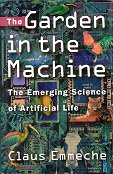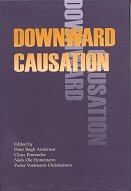Emmeche, a theoretical biologist, takes a look at the new area of
artificial life, and whether the "strong a-life" claims that
it really is life, not just a simulation, are justified. His
roving discussion covers von Neumann's self reproducing automata
(reproduction), life at the edge of chaos, Lindenmeyer's L-systems
(growth), Conway's Game of Life, Ray's Tierra (evolution), Reynold's
boids (emergence), and more.
He has interesting things to say about the dynamics of emergent
properties and self-organisation.
we can see
that a whole range of evolutionary phenomena are internal, inherent
properties of self-organized systems, and that natural selection need
not lie behind all the structures that biologists observe in nature.
... selection can now also be understood as the means by which a
dynamic system chooses its own trajectories or evolutionary paths.
The new
construction of a complex system from identical rules and identical
starting conditions can produce a somewhat identical result without
explicitly coding the macroscopic construction.
The key phrase here is "identical starting conditions".
When people get all computational about DNA, they go on about computer
programs, but they rarely mention that other crucial aspect: the
input. For life, that is the circumstances in which the DNA finds
itself: a given, determined by the previous generation (the local
environment of egg and womb, say), and by the external environment. As
Jack Cohen so memorably
puts it: "If you think it is just DNA, you don't worry about
giving the mother thalidomide". The same DNA with different
initial conditions (and a different environment) can result in different
organisms:
Waddington
himself made an attempt whereby ether treatment of fruit-fly larvae
could induce the development of adult phenotypes that were exact
copies of the kinds of bodily defective flies otherwise thought to
develop only by mutations ... He further demonstrated that by
continually changing environmental conditions, he could cause the
genetic assimilation of these altered phenotypes; that is, the change
would become stabilized via subsequent genetic changes. This was not
accomplished by any Lamarckian inheritance but by a form of feedback
between selection in the changed environment and embryonic development
via other routes in the epigenetic landscape
And even if we do know both the program of life, and its inputs,
there may not be any shortcuts to predicting the result (except by
executing a totally faithful simulation -- not terribly feasible -- on
a processor that runs faster than the real-time computation that life
"performs").
For
[computationally irreducible] complex systems there is no other way to
predict their evolution than by tracking it. We must wait and see what
happens. If this description also covers embryonic development, it
means that the precise form of the final individual (the total
phenotype) cannot be predicted, even with complete knowledge (which is
itself purely hypothetical) of the total genotype and the epigenetic
substrate.
Studying the
physical limitations on computation entails acknowledging that
computation, much as the measurement process in physics, is far from
completely idealizable or meta-physical. Computational processes are
subordinated to normal, natural laws. At the same time, these laws are
described by mathematics and computations based on this mathematics.
Hence, it is natural to conclude that the physical laws must have a
form that permits them to be executed in time and space. The laws that
describe our universe must be limited to algorithms that can in fact
be executed using this universe's bricks and mortar. The universe does
not permit us, for example, to build a computer with an infinitely
large memory that could help us to separate pi from an arbitrary
close-lying neighboring number.
He reiterates a useful distinction between two kinds of laws:
Perhaps we
ought to revive Kant ... and the distinction he used in another
context. This is the distinction between (a) systems that follow
a rule, i.e., consult a representation, some symbols, and make
computations based upon them ... ; versus (b) systems that operate
in accordance with a rule, i.e., where the system behaves as
if it had consulted a rule, but where the rule-like nature of the
system ... is instead caused by purely natural lawlike causality. Even
though my digestion is normally quite regular, my stomach is no
computer, which for each new piece of meat searches its memory for a
meat-digestion program. This does not prevent me from describing my
digestive system as if it were a computer, however.
Artificial life follows laws (the computer program), whereas
nature, including real life, acts in accordance with laws (the
laws of physics, chemistry and biology). Emmeche says it is possible
to describe a natural system as if it were a computer (Dennett
might call this the "computational stance"). Yet what is to
stop us equally well describing a computational system as if
it were real (the "strong a-life" stance, perhaps?)
Emmeche is certainly no "carbon chauvinist" -- he admits
the possibility of life based on other processes, but still only
physical real-world processes, not virtual ones.
It is
conceivable that life is not bound to a specific carbon-chain
chemistry, but it is probable that the ways in which life will
self-organize in alternative physical media-i.e., the concrete
embodiment it achieves, the species that will appear, and the types of
processes it contains-will depend on the specific physics that
characterize the given medium. That is, the independence of life-forms
from the medium (in the strong sense) is denied, but the possible
realization of life in other physical media is not excluded.
It's the difficulty of simulating everything that Emmech
appears to believe separates reality from artificial life.
Computer
organisms do not die at all in the biological sense; they simply cease
to exist. But real death is part of the living game. ... Life is also
death, dissolution, dung, and earth.
In particular, it's the fact that the artificial life simulations
are not "open".
of an artificial life program:
we cannot speak of genuine open-ended
evolution, for the system always seems to be caught in one attractor
or another, where the condition is thereafter a very specific one.
Life is
certainly a game, but it is not played according to fixed rules. The
rules themselves can evolve, and during evolution old rules can break
down.
genuine life
is fundamentally different than computer life, whose environment is
simulated. Computational forms of life do not stand in the same open,
nonspecified relation to its environment because the environment, too,
is of a purely computational nature: digital and determined.
"Openness" refers to the "gateway
events" that open up new regions of phase space for the
system to explore, so that it is not trapped in some static, bounded
space. I have a lot of sympathy for the position that genuinely alive
systems need to be open. However, just because existing simulations
are not "open", does that mean that no simulation
can be? Is openness a property only of the real world, or can it be a
property of virtual worlds, too? I am not convinced this question is
in any way settled. Emmech seems to be, however, and a late footnote,
during the argument against strong a-life, has a revealing
parenthesis:
Searle's
Chinese Room argument against strong AI ... may not be logically sound
in a strict sense (though still intuitively convincing), and his
biologism ... with respect to mental states is debateable, I think
that the argument against strong a-life can nevertheless be made over
a similar, though not quite analogical, scheme.
So an argument against strong a-life can be made that is similar to
Searle's logically unsound, and debateable, but "intuitively
convincing" argument? Intuitively convincing to who? Several
people, including Dennett and
Hofstadter, might disagree about that
convincingness.
I enjoyed the majority of this book, despite disagreeing with the
main conclusion. But I have a problem with the last chapter, "Simulating
Life: Postmodern Science". The book is translated from the
Danish. Apart from a couple of bobbles -- Brooks' "fast,
cheap, and out of control" is rendered as "quick,
cheap, and out of control", and Conway's
Game of Life is consistently
referred to as "the Life game" -- the translation reads
smoothly for the most part. This last chapter, however, might just as
well still be in the original Danish for all I got from it. In
previous chapters, my eyes passed over the text, and understanding
appeared in my head; here, my eyes passed over the text. I don't know
whether this is due to the translation, but I have a sneaking
suspicion it is due to the content. I don't appear to have a
Postmodern brain. (Judging from some things I have read about
the subject, this is not a lack
I lose any sleep over.)
All in all, there is a lot of interest here. Emmeche brings an
thoughtful view to the a-life debate, and raises lots of intriguing
issues. I am not convinced, however, that he has made his case against
the strong a-life view.

